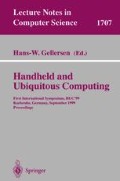Abstract
We introduce an efficient text input technique that can be used in various environments where conventional full-sized keyboards cannot be used. The technique, called POBox, consists of two steps for entering a word or a phrase. First, a user enters a small part of the word or some other attribute, and POBox dynamically searches a dictionary for candidate words and shows them to the user for selection. The user then selects the desired word from the candidate list, and POBox enters the word into the user’s document. POBox uses the context of the user’s document to help identify likely candidates. Many times POBox can predict the desired word based on the context. This allows the user to skip the first step and enter text even more efficiently. We show that the same technique can be applied to various handheld and ubiquitous computers including PDAs and cellular phones, where conventional full-sized keyboards are inadequate.
Access this chapter
Tax calculation will be finalised at checkout
Purchases are for personal use only
Preview
Unable to display preview. Download preview PDF.
References
Goldberg, D., and Richardson, C. Touch-typing with a stylus. In Proceedings of ACM INTERCHI’93 Conference on Human Factors in Computing Systems (CHI’93) (April 1993), Addison-Wesley, pp. 80–87.
Hashimoto, M., and Togasi, M. A virtual oval ieyboard and a vector input method for pen-based character input. In CHI’95 Conference Companion (May 1995), Addison-Wesley, pp. 254–255.
MacKenzie, I. S., Zhang, S. X., and Soukoreff, R. W. Text entry using soft keyboards. Behaviour & Information Technology. http://www.uoguelph.ca/imackenz/BIT3.html.
MacKenzie, I. S., and Zhang, S. Z. The design and evaluation of a high performance soft keyboard. In Proceedings of the ACM Conference on Human Factors in Computing Systems (CHI’99) (May 1999), Addison-Wesley. to appear.
Mankoff, J., and Abowd, G. D. Cirrin: A word-level unistroke keyboard for pen input. In Proceedings of the ACM Symposium on User Interface Software and Technology (UIST’98) (November 1998), ACM Press, pp. 213–214. http://www.cc.gatech.edu/fce/pendragon/cirrin.html.
Masui, T. An efficient text input method for pen-based computers. In Proceedings of the ACM Conference on Human Factors in Computing Systems (CHI’98) (April 1998), Addison-Wesley, pp. 328–335. http://www.csl.sony.co.jp/person/masui/papers/CHI98/CHI98.pdf.
Masui, T. Integrating pen operations for composition by example. In Proceedings of the ACM Symposium on User Interface Software and Technology (UIST’98) (November1998), ACM Press, pp. 211–212. http://www.csl.sony.co.jp/person/masui/papers/UIST98/UIST98.pdf.
Matias, E., MacKenzie, I. S., and Buxton, W. Half-qwerty: Typing with one hand using your two-handed skills. In CHI’96 Conference Companion (April 1996), ACM Press, pp. 51–52. http://www.dgp.toronto.edu/people/ematias/papers/chi96/
Perlin, K. Quikwriting: Continuous stylus-based text entry. In Proceedings of the ACM Symposium on User Interface Software and Technology (UIST’98) (November 1998), ACM Press, pp. 215–216. http://mrl.nyu.edu/perlin/demos/quikwriting.html.
Tegic Communications. T9. 2001 Western Avenue, Suite 250, Seattle, WA 98121. http://www.t9.com/
Textware Solutions. The Fitaly Keyboard. 83 Cambridge St., Burlington, MA, 01803 USA. http://www.twsolutions.com/fitaly/fitaly.htm
Textware Solutions. Instant Text version III. 83 Cambridge St., Burlington, MA, 01803 USA. http://www.twsolutions.com/overview/overview.htm
Venolia, D., and Neiberg, F. T-Cube: A fast, self-disclosing pen-based alphabet. In Proceedings of the ACM Conference on Human Factors in Computing Systems (CHI’94) (April 1994), Addison-Wesley, pp. 265–270.
Author information
Authors and Affiliations
Editor information
Editors and Affiliations
Rights and permissions
Copyright information
© 1999 Springer-Verlag Berlin Heidelberg
About this paper
Cite this paper
Masui, T. (1999). POBox: An Efficient Text Input Method for Handheld and Ubiquitous Computers. In: Gellersen, HW. (eds) Handheld and Ubiquitous Computing. HUC 1999. Lecture Notes in Computer Science, vol 1707. Springer, Berlin, Heidelberg. https://doi.org/10.1007/3-540-48157-5_27
Download citation
DOI: https://doi.org/10.1007/3-540-48157-5_27
Published:
Publisher Name: Springer, Berlin, Heidelberg
Print ISBN: 978-3-540-66550-2
Online ISBN: 978-3-540-48157-7
eBook Packages: Springer Book Archive

